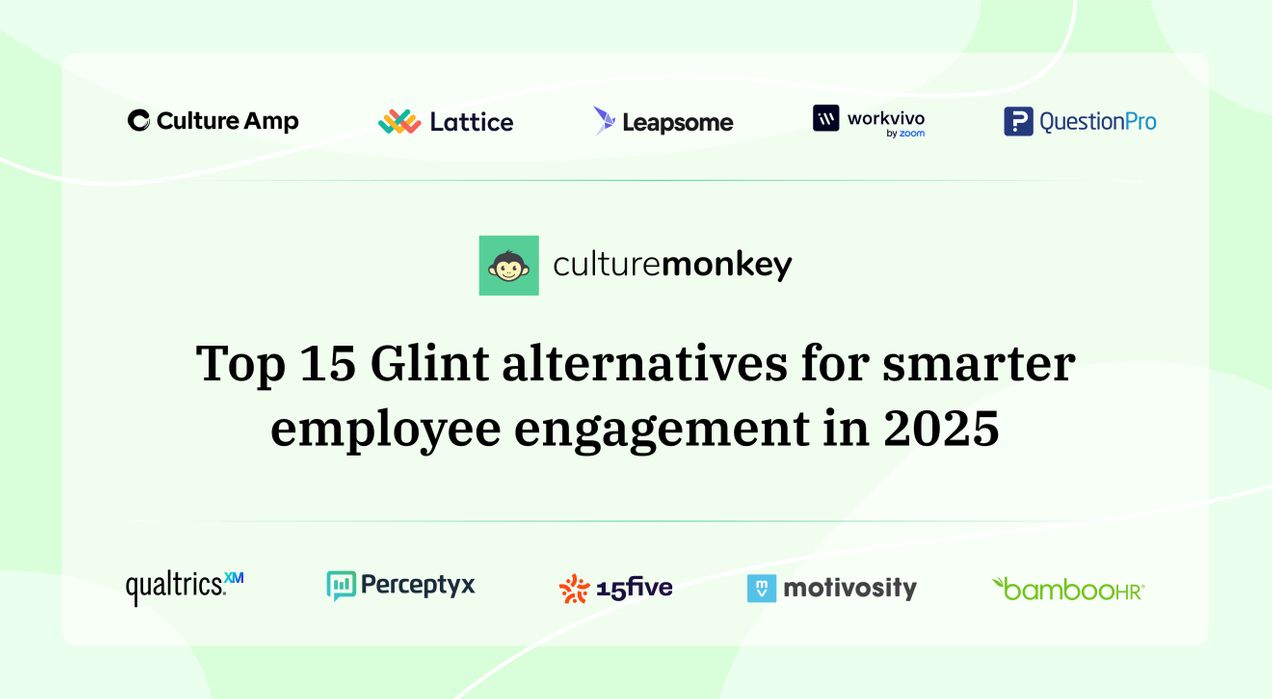10+ Best tools to detect employee disengagement in 2025
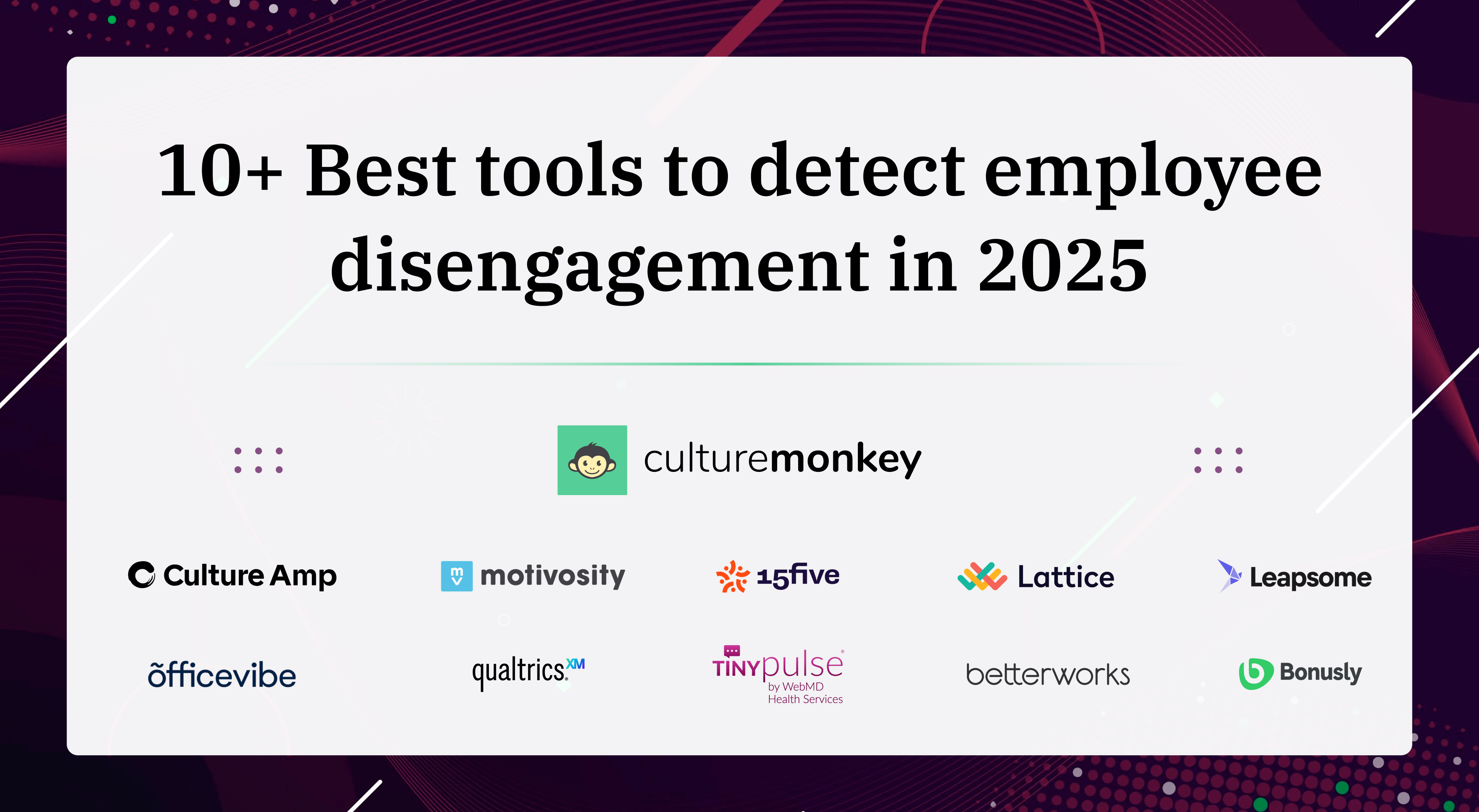
Ever tried talking to a plant that’s slowly dying? You water it, shift it closer to sunlight, maybe even whisper encouragement; yet nothing changes. Turns out, the roots were rotting long before the leaves drooped.
Employee disengagement works the same way. By the time you notice the silence, missed deadlines, or “I’m fine” responses, it’s already rooted deep. But what if you had a way to detect those early signs before they surfaced?
That’s where smart tools come in; not just to measure what’s obvious, but to sense what’s quietly slipping away. Let’s explore how to spot disengagement before it blooms.
What does employee disengagement actually look like?

Employee disengagement occurs as a steady decline in enthusiasm, accountability, and emotional connection to one’s work. Actively disengaged employees often show up physically but not mentally—delivering the bare minimum, avoiding collaboration, and displaying little interest in growth or feedback. They may be less responsive, emotionally withdrawn, and increasingly disconnected from team goals or company values.
According to Gallup’s State of the Global Workplace report 2025, only 23% of employees worldwide are actively engaged at work, leaving a staggering majority either passively disengaged or actively disengaged. These employees cost businesses in lost productivity, higher absenteeism, and increased turnover.
Recognizing disengagement early is critical—not just for maintaining performance, but also for safeguarding culture. It’s not always loud or disruptive; more often, it’s silent and subtle. The right tools can help managers detect these signals before they spiral into larger organizational challenges.
Why detecting disengagement early is critical for retention?
Spotting disengagement before it spirals lets you act smart—not scramble—to keep your top people engaged, productive, and sticking around. Here are the clear reasons why detecting disengagement early is mission-critical:
- Prevents turnover before it starts: Early insight gives managers a chance to course-correct, reducing the risk of good people quietly slipping away.
- Reduces replacement and productivity costs: When you catch disengagement early, you avoid the high cost of losing and replacing skilled employees.
- Avoids mass losses in disengagement impact: One disengaged employee can influence others—early detection stops the ripple effect from spreading across teams.
- Curbs “quiet cracking” before it bursts: Disengagement rarely starts loud—it starts with silence. Identifying those subtle signs early prevents deeper morale issues.
- Boosts engagement-linked performance: Employees who feel seen and heard early on are more likely to re-engage, perform better, and stay longer.
- Strengthens retention through recognition: Recognizing and addressing issues at the first signs of disengagement builds loyalty and improves retention.
- Enables proactive manager support: Managers can act with empathy and effectiveness when they're alerted early to signs of burnout or withdrawal.
- Protects culture and trust: Disengagement left unchecked can quietly erode team trust and culture. Early action keeps the organization aligned and healthy.
Top 5 signs your employees may be disengaged

Disengagement rarely announces itself. It’s quiet, gradual, and often mistaken for routine stress or personality shifts. But certain behavioral patterns can reveal early signs of emotional withdrawal. Here are the most common ones to look for:
- Drop in performance consistency: Employees who were once reliable begin missing deadlines, delivering lower-quality work, or showing inconsistent effort without clear external reasons.
- Minimal participation or input: Disengaged team members often avoid speaking up in meetings, offering ideas, or volunteering for new responsibilities—even when opportunities match their skillset.
- Visible lack of enthusiasm: A noticeable dip in energy, reduced initiative, or lack of excitement about work, team wins, or company updates can indicate deeper disengagement.
- Increased absenteeism or tardiness: Frequent unplanned leaves, late logins, or extended breaks may signal emotional detachment and can also disrupt team dynamics and put additional pressure on other team members
- Withdrawal from social or team activities: Employees pulling back from informal conversations, team events, or collaborative projects may be silently checking out of the company culture.
10+ Tools help identify disengaged employees before it’s too late
1. CultureMonkey
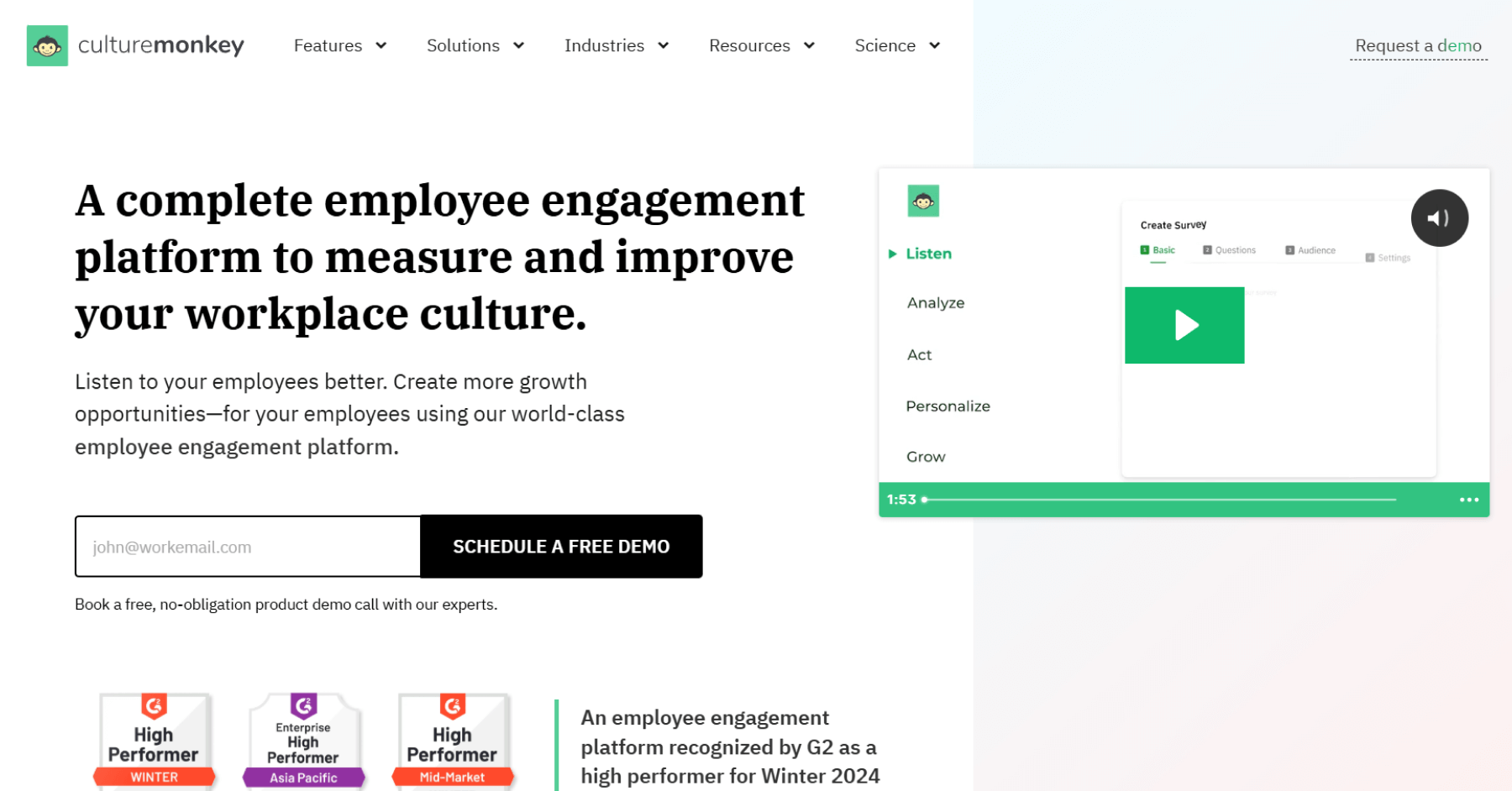
CultureMonkey is an enterprise-grade employee engagement platform built for enterprises that want to detect and address employee disengagement before it turns into attrition. With a science-backed approach and deep customization, it helps HR leaders capture honest feedback, uncover sentiment trends, and act with precision.
Whether you're managing a global workforce or rebooting your survey strategy, CultureMonkey makes disengagement detection seamless. Here’s how its features work to surface early warning signs.
| Feature | How it helps detect employee disengagement |
|---|---|
| Secure and compliant feedback | CultureMonkey is ISO 27001 certified, SOC-compliant, and GDPR-aligned, giving employees the confidence to share sensitive disengagement feedback. |
| Onboarding with strategic alignment | Provides a structured rollout that aligns survey strategy with disengagement risk areas, reducing friction in setup. |
| Built to scale insights | Detects disengagement trends across distributed teams and geographies without lags or data loss. |
| Cultural diagnostics before surveys | Identifies cultural weak points upfront and builds tailored surveys to uncover root causes of employee disengagement. |
| Templates for disengagement detection | Quickly launch research-backed surveys designed to pinpoint disengagement across departments and stages. |
| Survey fatigue safeguards | Prevents disengagement from being masked by survey burnout with lightweight, pulse-based survey formats. |
| Smart HRMS-based survey timing | Syncs real-time employee engagement data to trigger timely surveys when disengagement risk is high. |
| Quick survey setup and insights | Makes it simple to run frequent pulse checks that detect subtle shifts in employee sentiment. |
| Surveys in 150+ languages | Supports localized survey delivery in 150+ languages, helping detect disengagement signals across global and culturally diverse teams. |
| Mobile surveys for deskless teams | Empowers frontline, blue-collar, and non-desk employees to participate in feedback from their devices—uncovering disengagement in hard-to-reach workforce segments. |
| Anonymous two-way communication | Encourages employees to surface disengagement issues safely through anonymous two-way feedback. |
| Feedback across employee lifecycle | Detects disengagement at key lifecycle stages like onboarding, probation, exit, or internal mobility. |
| Heatmaps and scoring views | Highlights disengagement hotspots via heat maps and engagement scores, making patterns easy to act on. |
| AI-based text analysis | Uncovers hidden disengagement signals from open-ended responses through AI-powered theme and sentiment analysis. |
| AI alerts and guidance | Surfaces disengagement trends and provides AI-driven recommendations to intervene effectively. |
| Visual reports with filters | Helps HR teams filter data to detect disengagement at the team, manager, or location level. |
| Custom reports by segment | Custom reports zero in on at-risk teams or cohorts showing signs of disengagement. |
| Dual dashboards for alignment | Let's HR and leadership spot disengagement trends at both micro and macro levels. |
| Expert-led engagement support | Provides expert help in analyzing disengagement signals and implementing engagement strategies. |
| Track historic engagement trends | Tracks disengagement over time and uncovers long-term patterns for preventive action. |
| Role-based insight access | Ensures the right leaders see the disengagement signals, enabling targeted interventions. |
| SSO for better participation | Removes login friction so more employees participate in surveys, boosting visibility into disengagement. |
Key takeaway
| Takeaway | Details |
|---|---|
| Pricing | Contact sales |
| G2’s score | 4.7 out of 5 |
| Capterra score | N/A |
| Pros | Seamless to use for HR teams, great reporting insights, and excellent customer support. (Source: G2) |
| Cons | No major issues reported. Email-based survey launch may need clarification. (Source: G2) |
2. Culture Amp
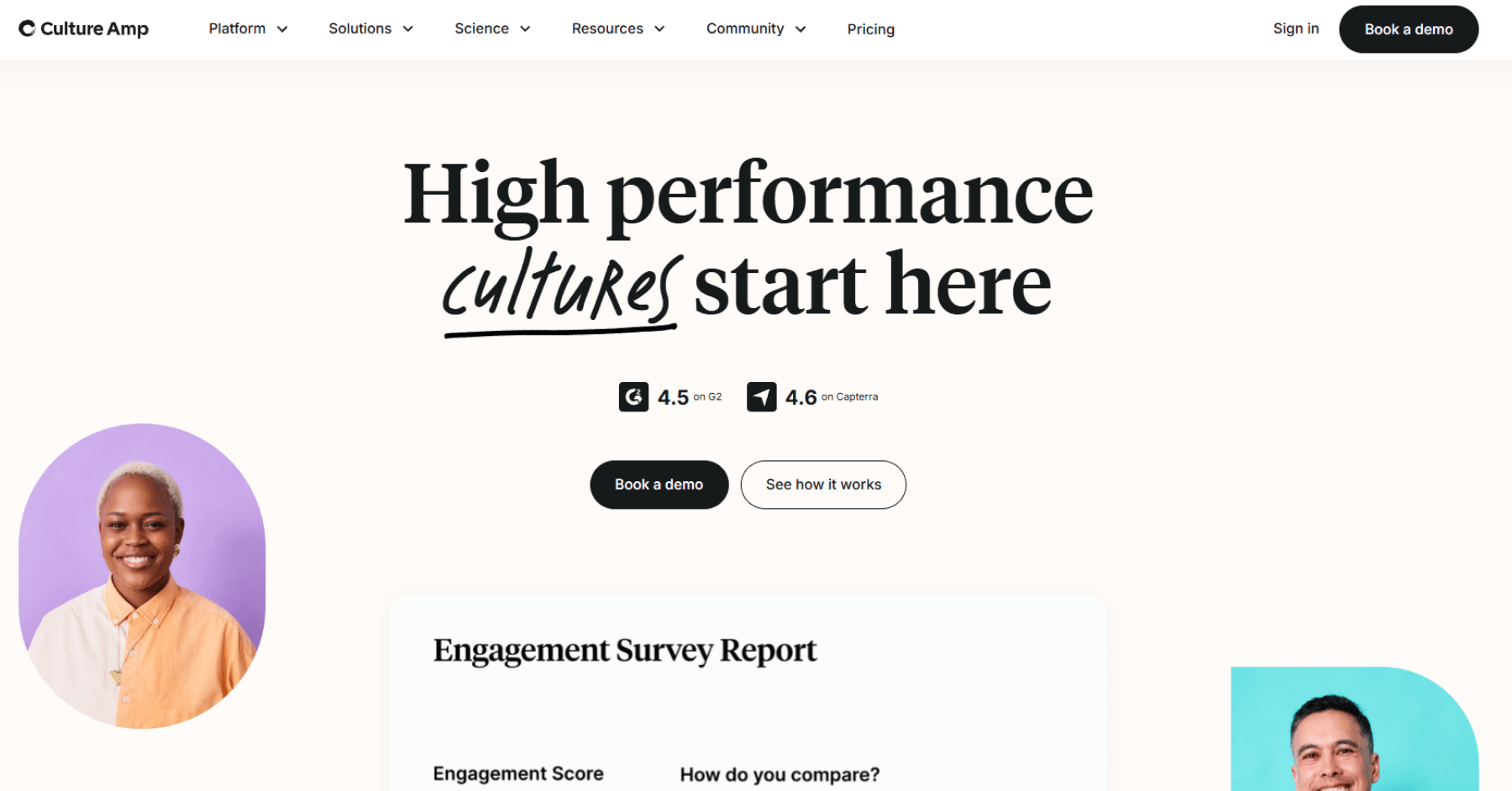
| Feature | How it helps detect employee disengagement |
|---|---|
| AI-powered comment summarization | Delivers instant, unbiased summaries of open-ended survey responses—surfaces disengagement sentiment without manual analysis. |
| Science-backed pulse surveys | Enables frequent, lightweight check-ins to detect shifts in engagement trends and disengagement triggers early. |
| Benchmarks for comparison | Contextualizes employee engagement scores against industry and regional standards—spot underperformance and disengagement risks. |
| AI-driven insights and action | Translates survey feedback into actionable guidance and auto-generated plans, helping nip disengagement in the bud. |
| One-click ready surveys | Offers research-backed templates that let you quickly launch engagement checks—making it easy to spot disengagement across teams. |
Key takeaway
| Takeaway | Details |
|---|---|
| Pricing | Contact sales |
| G2’s score | 4.5 out of 5 |
| Capterra score | 4.6 out of 5 |
| Pros | Easy to use, clear interface, and useful trend tracking over time. (Source: G2) |
| Cons | Hard to interpret survey results without support; slow response time during tight deadlines. (Source: G2) |
3. WorkTango
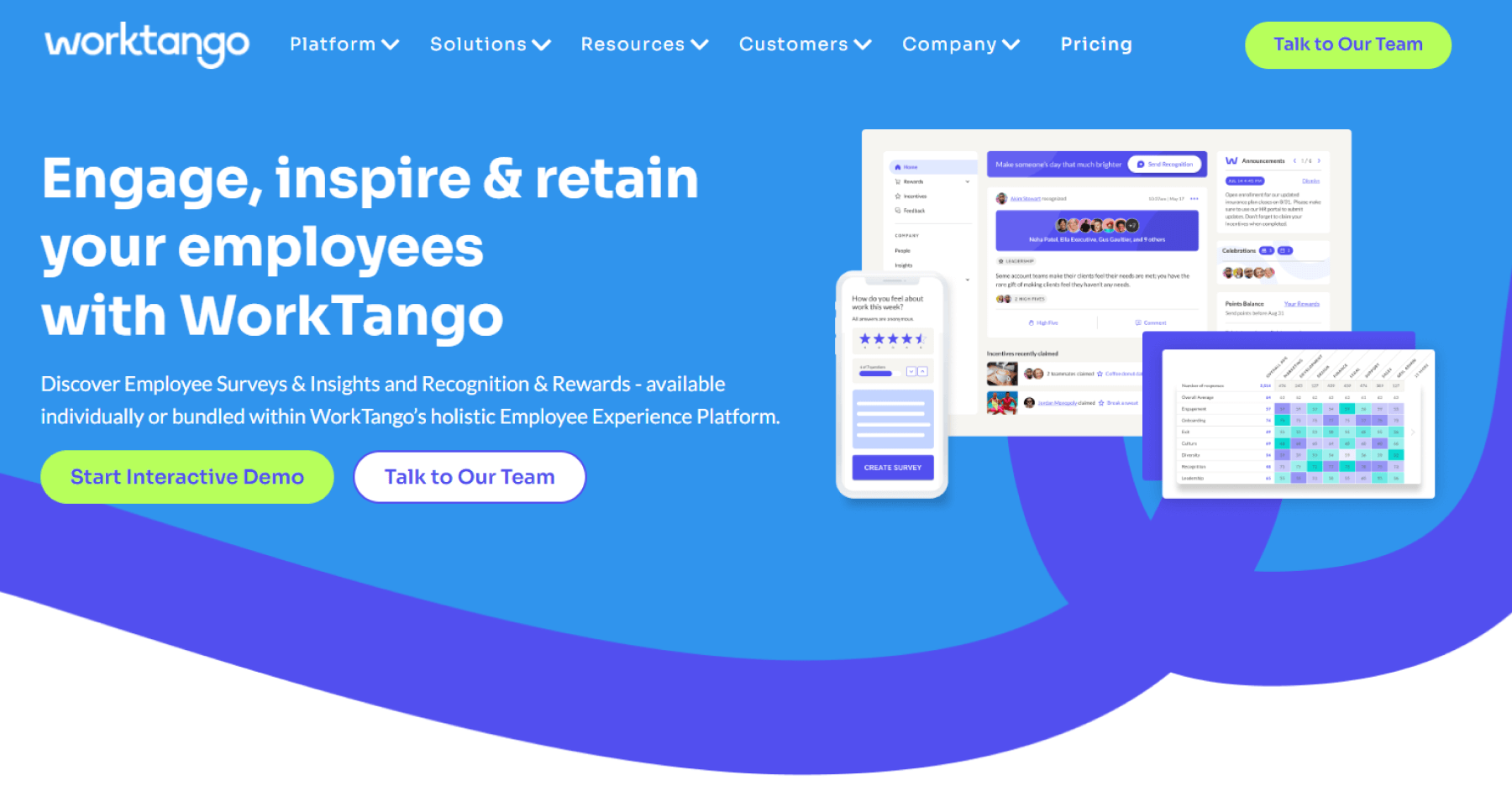
| Feature | How it helps detect employee disengagement |
|---|---|
| Unlimited lifecycle surveys | Enables continuous pulse surveys across the employee lifecycle, spotting disengagement at every stage, from onboarding to exit. |
| Real-time dashboards & benchmarks | Offers live dashboards and industry/regional benchmarks to surface engagement gaps early and in context. |
| Anonymous feedback channels | Encourages honest, candid responses through anonymity—critical for detecting true disengagement sentiment. |
| AI‑powered comment summaries | Automatically summarizes open-ended survey feedback, revealing disengagement themes without manual review. |
| Recognition & rewards insights | Tracks recognition behaviors and reward patterns to flag disengagement risks through a lack of peer appreciation. |
Key takeaway
| Takeaway | Details |
|---|---|
| Pricing | Contact sales |
| G2’s score | 4.7 out of 5 |
| Capterra score | 4.9 out of 5 |
| Pros | Highly user-friendly with fast and helpful support. (Source: G2) |
| Cons | Lacks advanced customization for surveys and reporting. (Source: G2) |
4. Motivosity
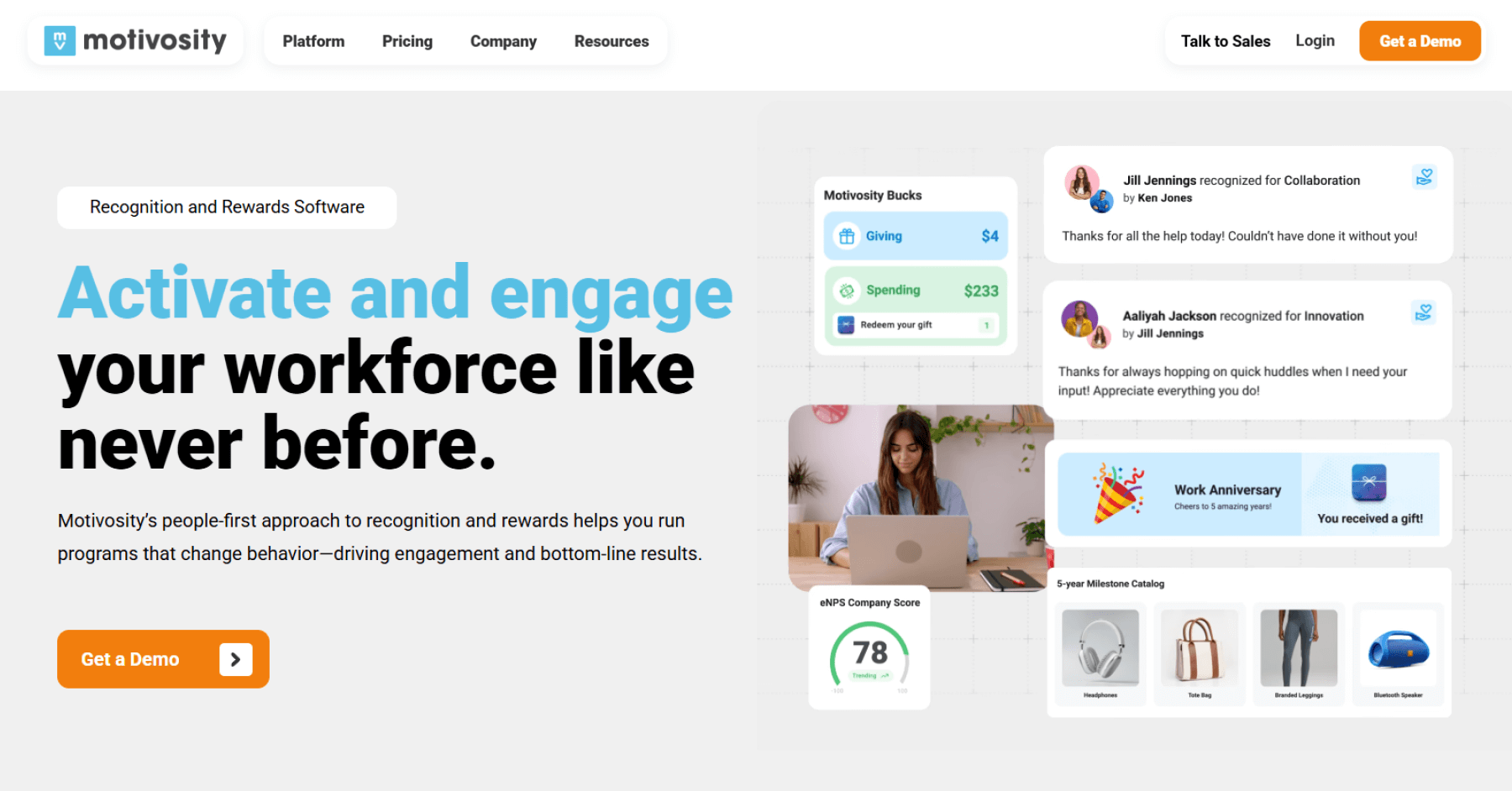
| Feature | How it helps detect employee disengagement |
|---|---|
| Peer recognition on social feed | Creates a social platform where lack of recognition or silence can highlight early disengagement—helping spot who isn’t being seen. |
| Public thank‑you notes | Personalized, visible appreciation lets absence or decline in participation serve as early warning signals of disengagement. |
| eNPS and pulse surveys | Measures loyalty and sentiment regularly, surfacing disengagement patterns before they translate into turnover intention. |
| Interactive employee spaces | Encourages community-building through common-interest hubs—disengagement becomes visible when participation drops or goes quiet. |
| Challenges & reward tracking | Engages employees through incentive-based tasks—low involvement or declining reward interest signals potential disengagement early. |
Key takeaway
| Takeaway | Details |
|---|---|
| Pricing | Contact sales |
| G2’s score | 4.7 out of 5 |
| Capterra score | 4.8 out of 5 |
| Pros | Useful survey tool with insightful heatmaps for tracking employee eNPS. (Source: G2) |
| Cons | Limited configuration of NPS surveys and weak Microsoft Teams integration. (Source: G2) |
5. 15Five
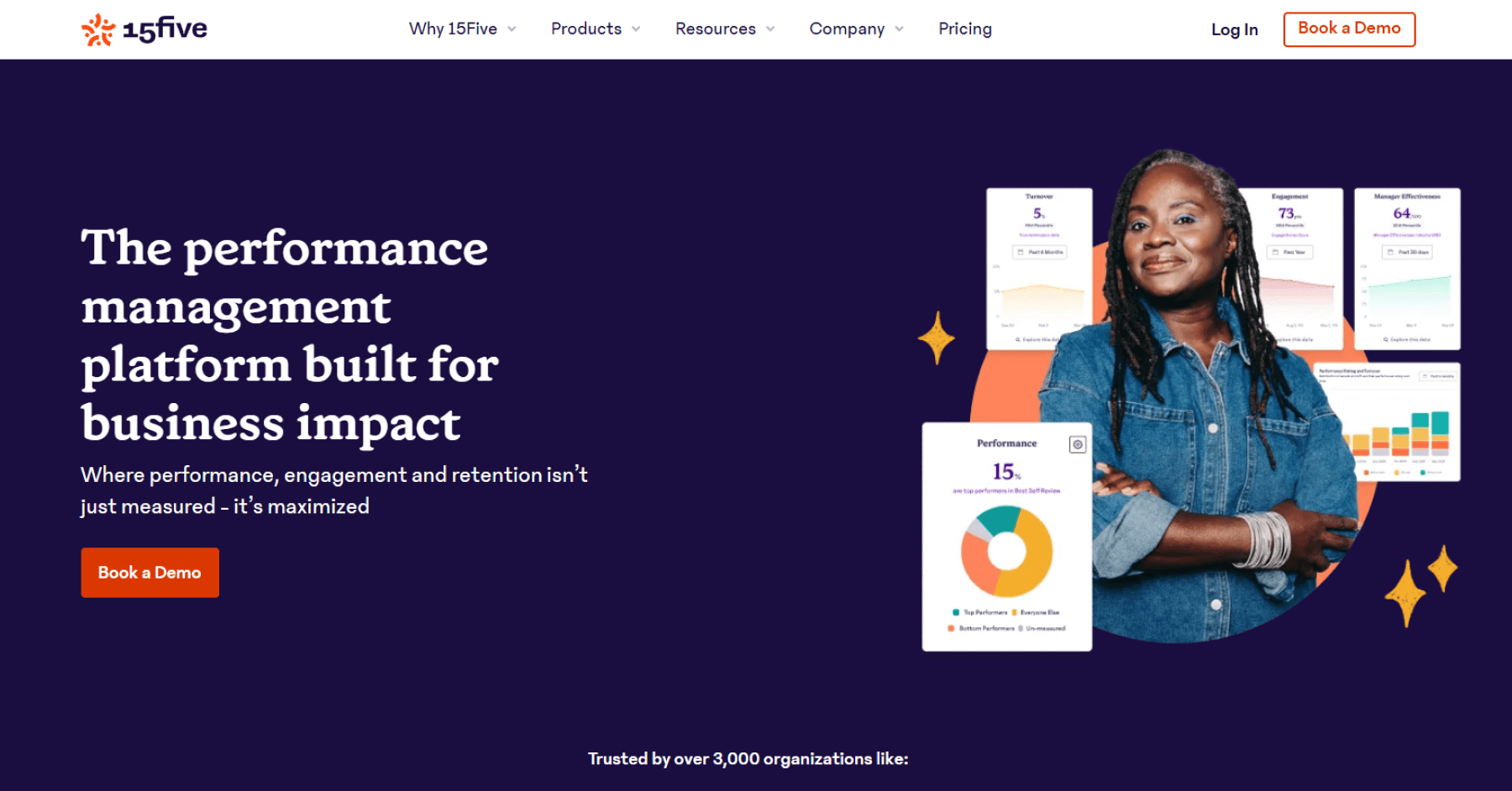
| Feature | How it helps detect employee disengagement |
|---|---|
| Lightweight Pulse question | Injects a simple “How did you feel?” question into every Check‑in, offering consistent, real‑time morale signals—ideal for spotting early disengagement at scale. |
| Predictive impact dashboards | Illuminates engagement trends with dashboards that help managers identify disengagement patterns before they escalate. |
| Built‑in action plan workflow | Turns disengagement data into targeted action plans—so managers can follow through, not just observe. |
| Engagement campaign templates | Lets you quickly deploy well‑designed engagement surveys with minimal setup, enabling swift detection of disengagement areas. |
| 1‑on‑1 agenda integration | Automatically surfaces Check‑in insights into manager‑employee meetings—so disengagement cues drive real conversations. |
Key takeaway
| Takeaway | Details |
|---|---|
| Pricing | $4 per user/month |
| G2’s score | 4.6 out of 5 |
| Capterra score | 4.7 out of 5 |
| Pros | Clean interface, smooth onboarding, and well-designed feedback workflows. (Source: G2) |
| Cons | Some engagement data may be inaccurate and hard to validate. (Source: G2) |
6. Lattice
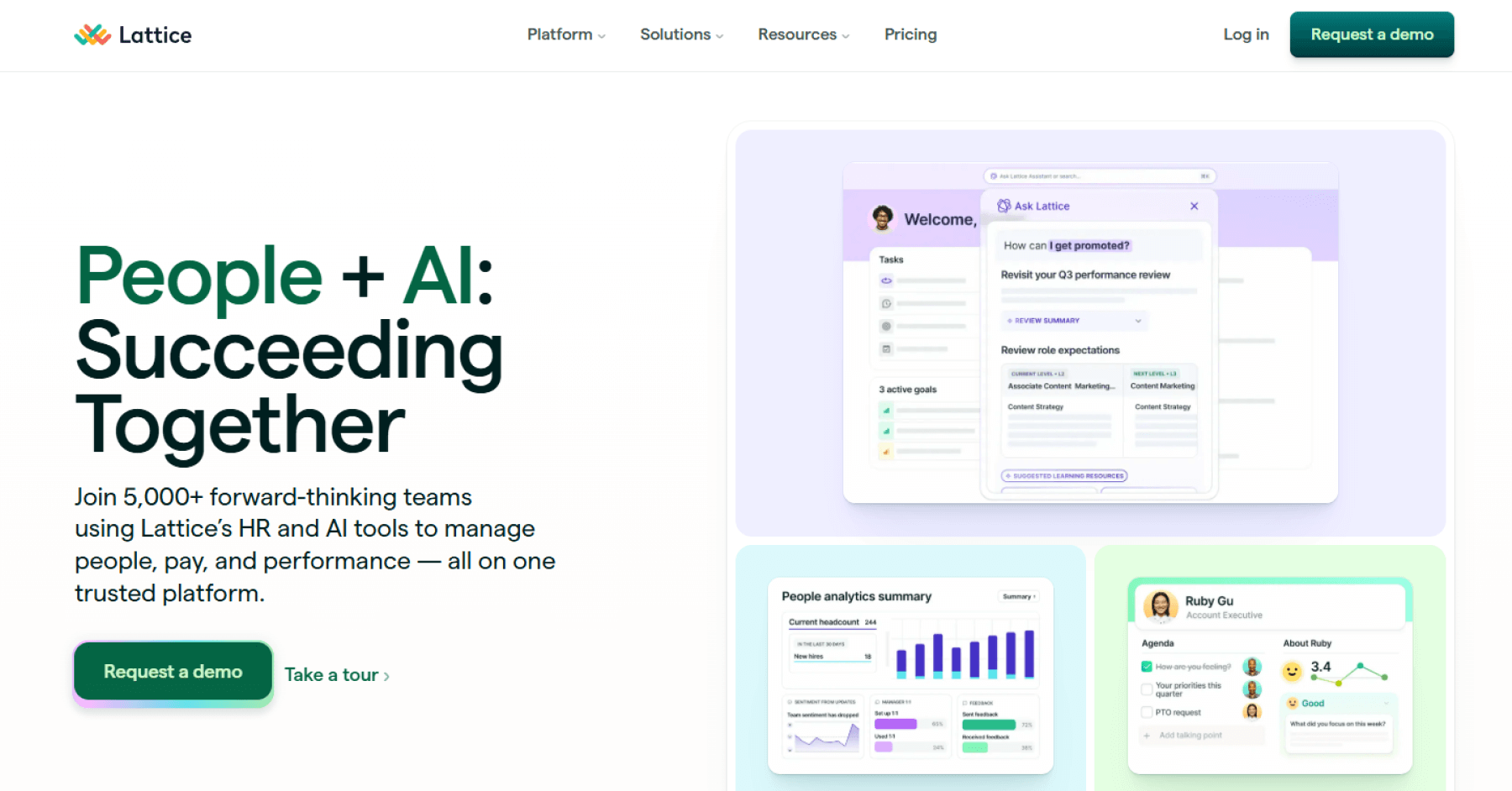
| Feature | How it helps detect employee disengagement |
|---|---|
| AI-driven key driver analysis | Uses AI to surface top themes impacting engagement scores—helping managers prioritize what truly drives disengagement. |
| Sentiment and heatmap analytics | Visualizes team mood and detects hot spots of disengagement through sentiment analysis and heatmap overlays. |
| Integrated continuous feedback | Embeds ongoing feedback via pulse surveys, 1-on-1s, and reviews—making early disengagement easy to spot. |
| Real-time dashboards for managers | Equips managers with live engagement data and alerts, enabling fast recognition of disengagement trends. |
| Custom review and feedback cycles | Allows for tailored review, survey, and feedback cadences—ideal for identifying disengagement through targeted checks. |
Key takeaway
| Takeaway | Details |
|---|---|
| Pricing | Contact sales |
| G2’s score | 4.7 out of 5 |
| Capterra score | 4.5 out of 5 |
| Pros | Beautiful UI, easy setup, and API integration with other tools. (Source: G2) |
| Cons | Frequent changes in customer reps; survey editing can feel restricted. (Source: G2) |
7. Leapsome
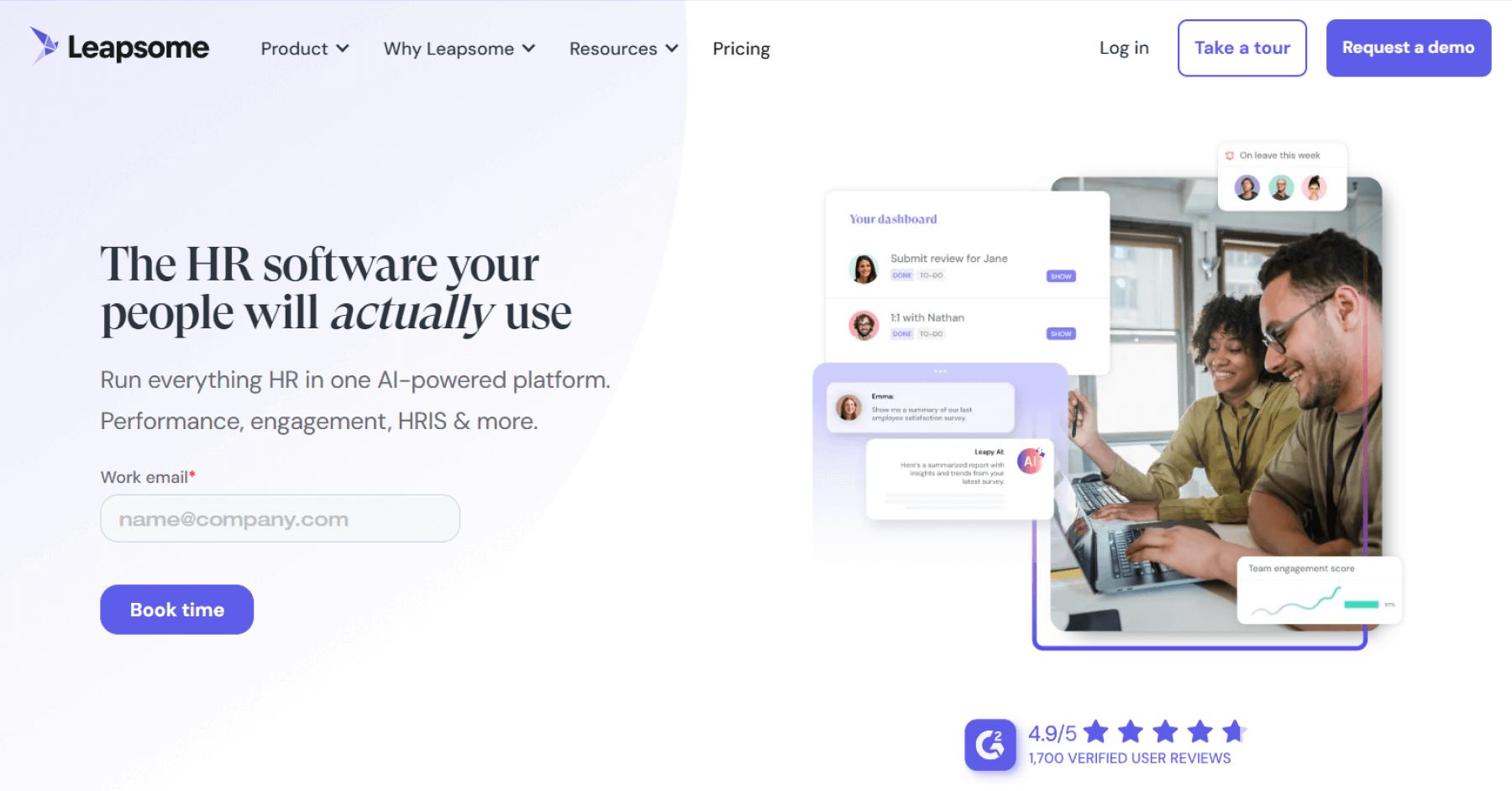
| Feature | How it helps detect employee disengagement |
|---|---|
| AI-powered survey analytics | Instantly summarizes feedback and highlights sentiment shifts, helping you spot disengagement themes quickly without manual review. |
| Intelligent impact drivers | Identifies which survey questions most influence others, helping prioritize interventions that can effectively reduce disengagement. |
| Continuous feedback integration | Embeds regular pulse surveys, 1‑on‑1s, and reviews into employee workflows—ideal for early detection of disengagement patterns. |
| Goal‑survey performance sync | Links engagement data with performance goals and reviews, enabling clear insight into how disengagement impacts overall productivity. |
| Modular AI Copilot support | Offers AI-driven summaries, suggestions, and action plans tailored to engagement challenges—empowering managers to act swiftly on early warning signs. |
Key takeaway
| Takeaway | Details |
|---|---|
| Pricing | Contact sales |
| G2’s score | 4.8 out of 5 |
| Capterra score | 4.6 out of 5 |
| Pros | Excellent survey analytics with strong filtering and benchmarking tools. (Source: G2) |
| Cons | Survey logic and question branching could be more customizable. (Source: G2) |
8. Workleap’s Officevibe
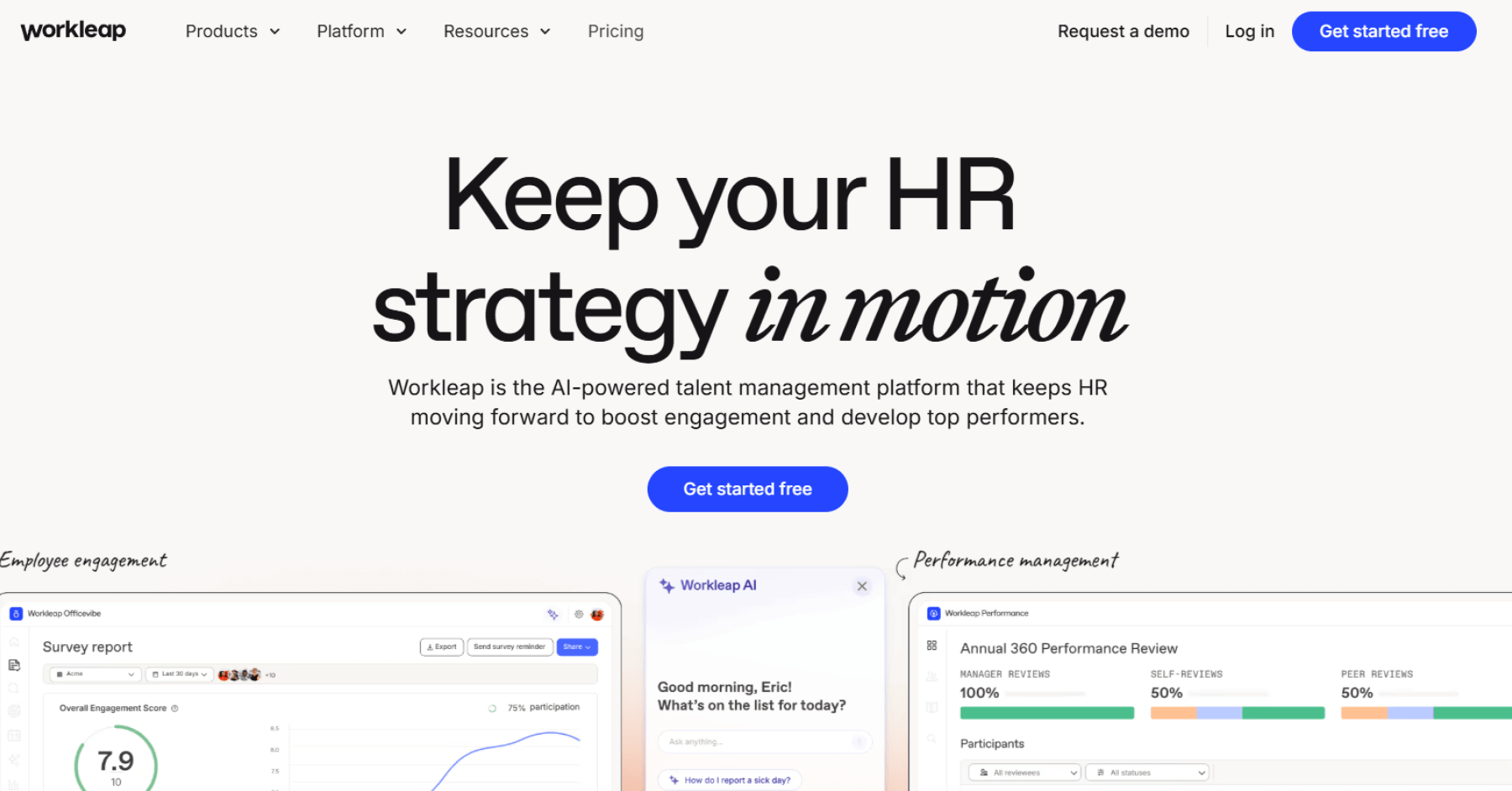
| Feature | How it helps detect employee disengagement |
|---|---|
| Science‑based pulse surveys | Delivers frequent, research-backed check-ins that reveal shifts in engagement before disengagement sets in. |
| Anonymous feedback tools | Creates a safe channel for candid employee insights—unfiltered feedback often reveals early warning signs of disengagement. |
| AI‑powered feedback analysis | Synthesizes written responses into sentiment summaries and trend insights, uncovering nuanced signs of disengagement without manual effort. |
| Integrated recognition features | Monitors peer recognition patterns—lack of acknowledgment or drop in shoutouts can indicate disengagement trends. |
| Real-time dashboards & alerts | Enables rapid detection of dips in engagement through live dashboards and notifications, allowing early intervention. |
Key takeaway
| Takeaway | Details |
|---|---|
| Pricing | $5 per user/month |
| G2’s score | 4.7 out of 5 |
| Capterra score | 4.8 out of 5 |
| Pros | Easy-to-use surveys with real-time feedback analytics. (Source: G2) |
| Cons | Needs more customization and stronger reporting filters. (Source: G2) |
9. Qualtrics
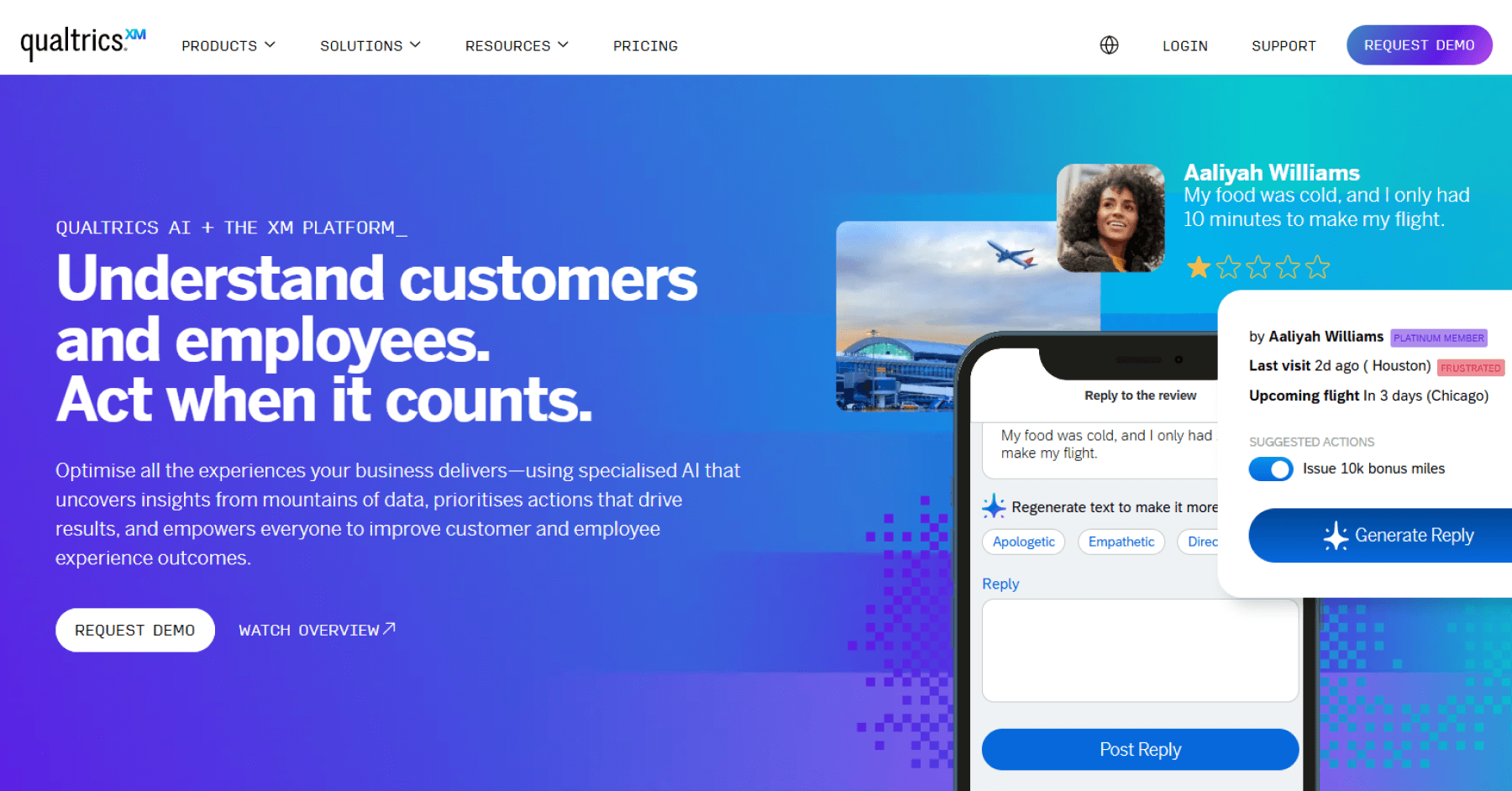
| Feature | How it helps detect employee disengagement |
|---|---|
| Passive listening mechanisms | Monitors communication trends across channels to surface subtle disengagement cues between formal touchpoints. |
| Extensive benchmarkable metrics | Offers 300+ benchmark items (like intent to stay and well-being) to flag areas where disengagement may be forming. |
| AI‑generated open feedback summaries | Condenses open-ended responses into sentiment themes—making hidden disengagement insights instantly visible. |
| Interactive AI assistant | Lets leaders query dashboards in natural language to quickly uncover disengagement trends and their root causes. |
| 360° feedback with smart scheduling | Automates continuous, relevant feedback loops throughout the employee lifecycle to catch disengagement early. |
Key takeaway
| Takeaway | Details |
|---|---|
| Pricing | Contact sales |
| G2’s score | 4.4 out of 5 |
| Capterra score | N/A |
| Pros | Powerful benchmarking and visually rich dashboards. (Source: G2) |
| Cons | Steep learning curve, limited support accessibility, and high pricing. (Source: G2) |
10. TINYpulse
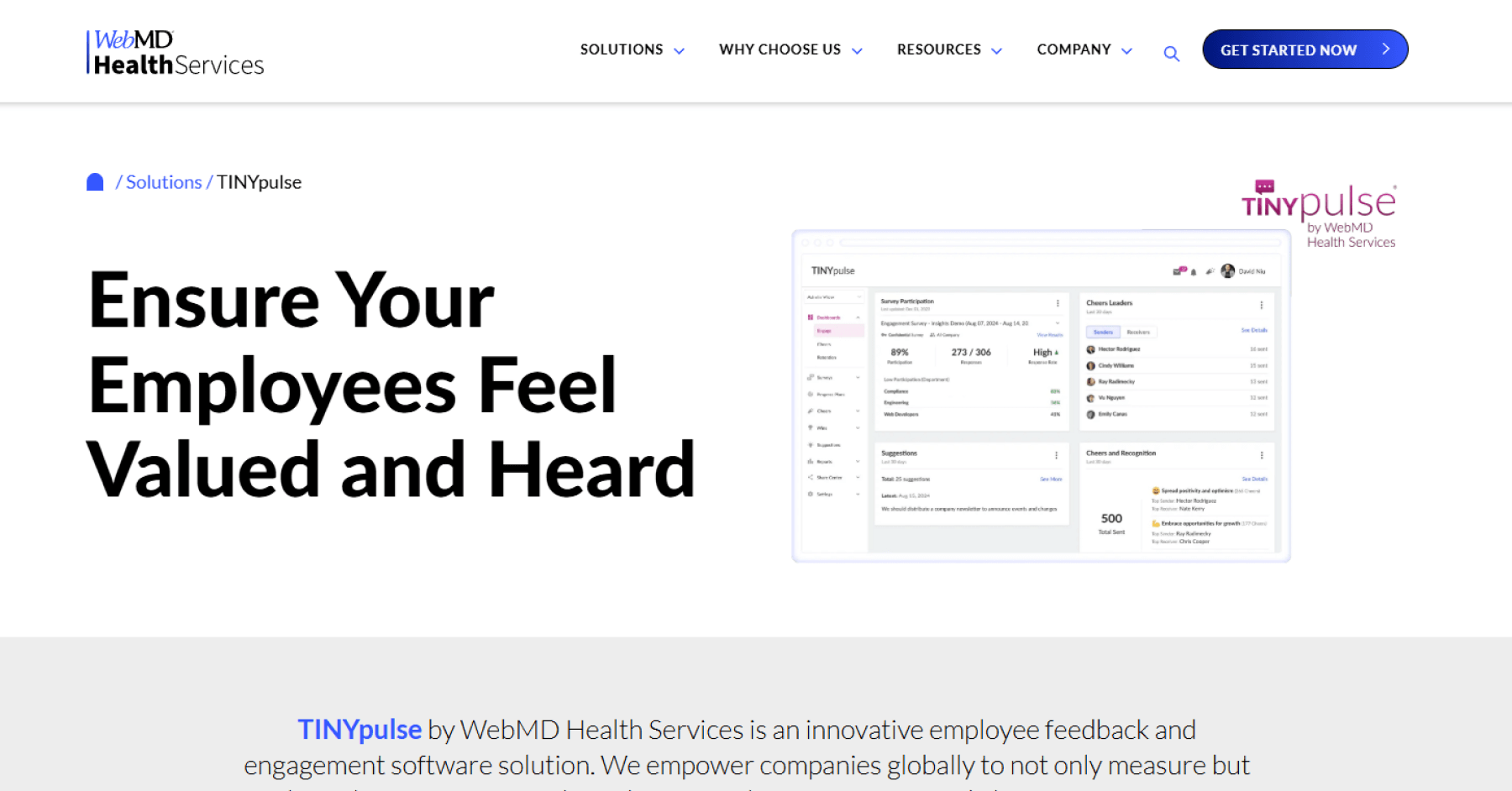
| Feature | How it helps detect employee disengagement |
|---|---|
| Frequent one-question pulses | Sends weekly or biweekly mini-surveys that quickly reveal drops in sentiment before disengagement deepens. |
| Cheers for Peers recognition | Peer-to-peer shoutouts (or their absence) serve as visible cues for declining connection and early disengagement. |
| Anonymous suggestion box | Enables private feedback with full anonymity—ideal for uncovering disengagement issues employees might otherwise hide. |
| Interactive engagement dashboards | Visual dashboards track engagement trends over time, making it easier to spot emerging disengagement patterns across teams. |
| Integrated Slack/Gmail tools | Let's employees respond to surveys, send recognition, and share feedback right in communication tools—boosting visibility into disengagement even for remote or busy teams. |
Key takeaway
| Takeaway | Details |
|---|---|
| Pricing | Contact sales |
| G2’s score | 4.4 out of 5 |
| Capterra score | 4.8 out of 5 |
| Pros | Easy to use, anonymous, and great for gauging employee sentiment. (Source: G2) |
| Cons | Can’t manually remind employees to complete surveys. (Source: G2) |
11. Betterworks
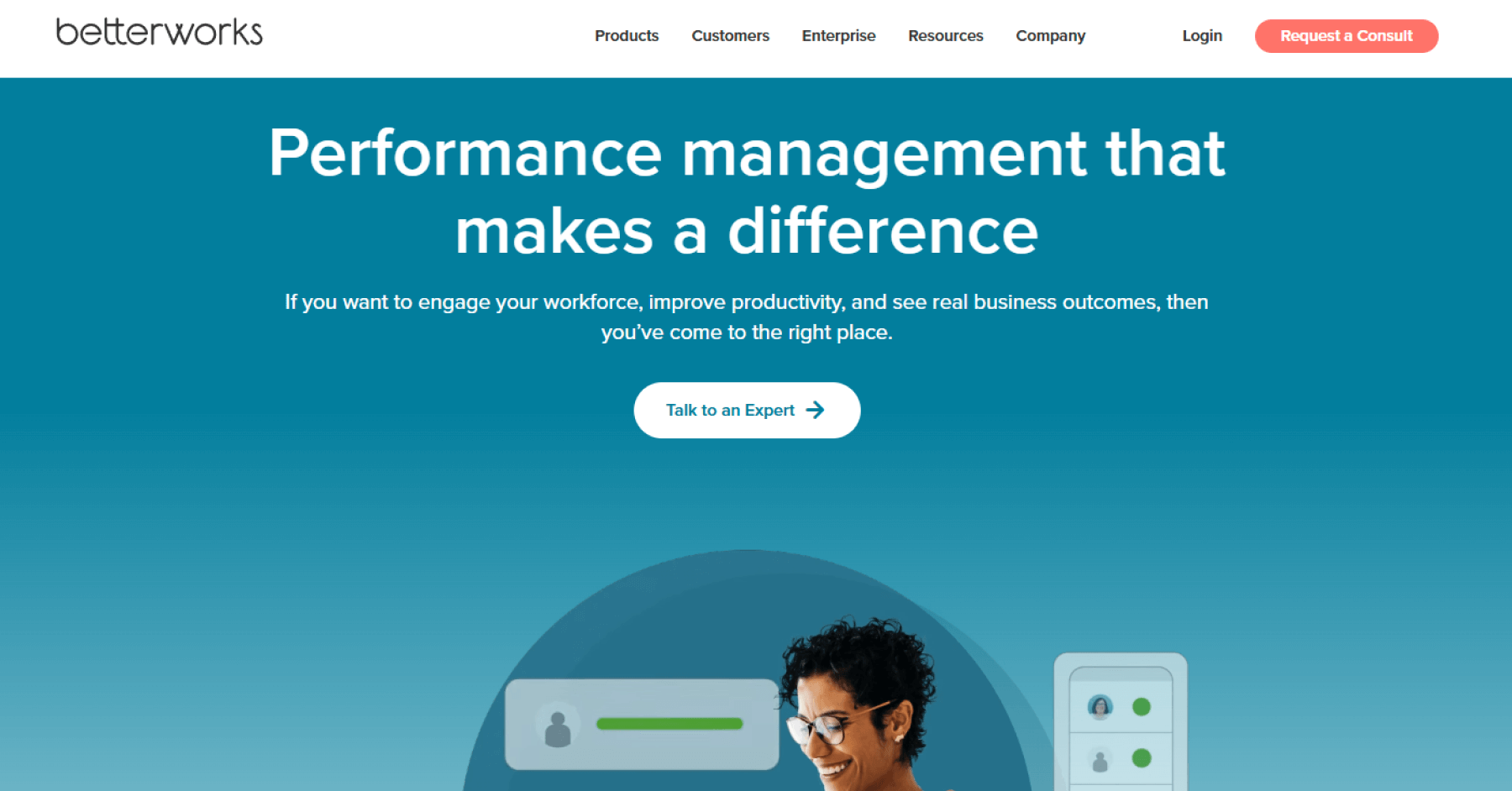
| Feature | How it helps detect employee disengagement |
|---|---|
| Continuous lifecycle engagement surveys | Captures feedback at every stage—from onboarding to exit—surface disengagement at critical employee moments. |
| Voice-enabled two-way feedback | Breaks down barriers between leaders and employees—allowing honest conversation that can uncover hidden disengagement. |
| AI-insight-driven action plans | Transforms engagement data into targeted, actionable guidance—empowering managers to address disengagement proactively. |
| Benchmarked pulse question library | Offers industry-validated, quick survey templates—making it easier to spot undercurrent disengagement across teams. |
| Live dashboards with benchmarks | Visualizes real-time engagement trends and compares them to benchmarks—helping identify teams at higher risk of disengagement. |
Key takeaway
| Takeaway | Details |
|---|---|
| Pricing | Contact sales |
| G2’s score | 4.4 out of 5 |
| Capterra score | 4.3 out of 5 |
| Pros | Easy-to-navigate interface that feels intuitive. (Source: G2) |
| Cons | Limited control over managing survey participants. (Source: G2) |
12. Bonusly
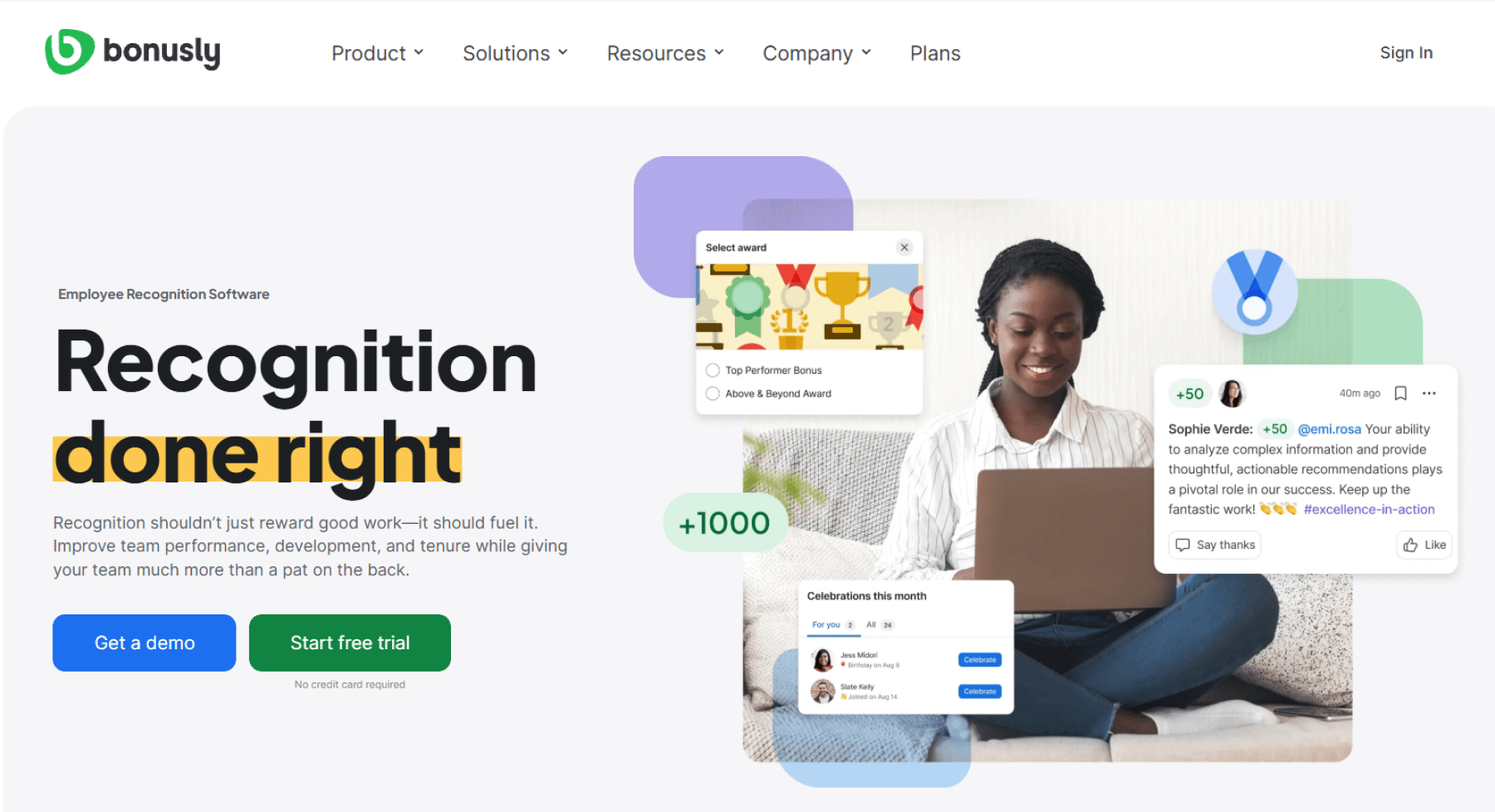
| Feature | How it helps detect employee disengagement |
|---|---|
| Peer-to-peer micro‑bonuses | Encourages frequent, small acts of recognition—so a drop in bonuses can signal early disengagement among individuals. |
| Automated milestone celebrations | Surface disengagement when key occasions (like anniversaries or quarterly wins) pass without recognition acknowledgment. |
| Reward catalog personalization | Allows employees to redeem points for meaningful rewards—low redemption rates may indicate disengagement or lack of employee motivation. |
| Public recognition feed | Visible recognition reinforces belonging—silence on the feed helps spot employees who may be quietly disengaged. |
| Manager dashboard insights | Offers leaders real-time visibility into recognition patterns, helping spot teams or individuals showing disengagement signals. |
Key takeaway
| Takeaway | Details |
|---|---|
| Pricing | Contact sales |
| G2’s score | 4.7 out of 5 |
| Capterra score | 4.8 out of 5 |
| Pros | Simple to use, great Slack integration, and transparent recognition. (Source: G2) |
| Cons | Points expire, and some users game the system to use them up. (Source: G2) |
What features should a disengagement detection tool have?
To detect employee disengagement before it leads to turnover or performance issues, your tool needs to do more than just collect survey data. Here are ten essential features every disengagement detection platform should offer.
- Pulse survey automation: The tool should allow you to schedule short, recurring surveys that capture frequent sentiment changes without exhausting employees.
- Pre-built lifecycle survey templates: Built-in templates for key moments like onboarding, promotions, and exits help identify disengagement risks across the employee journey.
- Anonymous feedback with response routing: Employees should be able to share candid concerns anonymously, while the tool routes critical feedback to the right manager without exposing identity.
- AI-powered sentiment and theme analysis: Open-ended feedback should be automatically analyzed to extract emotion, tone, and recurring themes—surfacing silent disengagement signals.
- Dual-layer dashboards for HR and managers: The platform should provide team-level insights for managers and aggregate views for HR and leadership to act at the right level.
- Smart survey fatigue controls: A strong tool avoids over-surveying by rotating question sets or capping frequency—ensuring you don’t create disengagement while trying to measure it.
- Role-based access control: Enterprise-grade platforms must offer granular access settings so only the right people can view specific engagement data.
- Real-time heatmaps and scoring: Engagement scores should be visualized across functions and locations, helping pinpoint disengagement hotspots quickly.
- Integration with HRIS and chat platforms: Tools should sync with systems like HRIS, Slack, or Teams to time surveys effectively and reach deskless or global employees.
- Guided engagement reboot framework: For teams restarting their engagement strategy, a well-structured launch roadmap helps gather authentic feedback and uncover latent disengagement.
These features make disengagement detection practical, scalable, and actionable, turning passive feedback into proactive strategy. Tools that include these functions don’t just gather data; they help you act before employees disconnect completely.
Why is CultureMonkey the top all-in-one platform to measure disengagement
When it comes to detecting employee disengagement with precision, speed, and scale, CultureMonkey stands out as the most complete solution. Here are seven clear reasons why it leads the way:
- Pre-survey diagnostics and customization: CultureMonkey helps organizations identify cultural gaps upfront and tailor survey strategies that target disengagement triggers from the start.
- Multilingual surveys across 150+ languages: It enables global teams to respond survey in their native language, increasing employee engagement, survey participation and surfacing localized disengagement patterns.
- Mobile-friendly surveys for deskless teams: Whether in warehouses, retail floors, or field locations, employees can easily share feedback via mobile, ensuring disengagement is never missed due to device or location limitations.
- Anonymous conversations with smart routing: Employees can submit honest feedback with full anonymity, while smart routing ensures the right managers are alerted for timely action.
- AI-powered sentiment and text intelligence: The platform analyzes open-ended feedback to detect early emotional shifts and hidden disengagement signals at scale.
- Role-based dashboards with real-time heatmaps: Team leads and HR can access the right level of insights, with disengagement trends visualized through heatmaps for quick intervention.
- Seamless integrations with HRIS and comms tools: CultureMonkey connects with HR systems and platforms like Slack and WhatsApp to automate survey delivery and make employee feedback collection frictionless.
How AI-powered feedback tools spot disengagement trends early

AI-powered tools do more than automate feedback collection; they uncover patterns that humans might miss. Here are five ways these tools help detect disengagement before it affects performance or retention:
- Sentiment analysis at scale: AI scans thousands of open-text responses to detect tone, emotional shifts, and negative sentiment trends, flagging early signs of disengagement across teams.
- Theme clustering for deeper insights: Instead of sifting through employee feedback manually, AI groups similar responses by topic, helping leaders identify common disengagement drivers quickly.
- Predictive risk scoring: Advanced models assign risk scores to individuals or teams based on past engagement data, highlighting who may be heading toward disengagement.
- Anomaly detection in response behavior: AI tools flag unusual changes in participation or feedback tone, making it easier to spot disengagement even when employees do not express it explicitly.
- Auto-generated action recommendations: Based on identified issues, the system suggests targeted next steps—giving managers clear direction on how to re-engage at-risk employees.
What types of surveys help reveal employee disengagement?
Not all surveys are built to detect disengagement. To uncover the emotional distance employees may feel, organizations need to use specific survey formats tailored to expose early warning signs. Here are the most effective surveys to reveal employee disengagement:
- Pulse surveys to track sentiment: These are short, recurring surveys that help track engagement trends over time—making it easier to catch dips in morale and motivation early.
- Employee engagement surveys: Designed to measure core drivers like purpose, recognition, growth, and communication, these employee engagement surveys reveal whether employees feel emotionally connected to their work.
- eNPS surveys for loyalty insights: The employee net promoter score helps gauge how likely employees are to recommend their workplace—a low score often signals underlying disengagement.
- Onboarding surveys to assess early experience: Disengagement can start early. These surveys reveal how new hires feel about their welcome, training, and first 90 days—key moments that shape long-term engagement.
- Exit surveys to identify disengagement triggers: By capturing honest feedback from departing employees, these surveys highlight common disengagement patterns that may be affecting retention.
- Manager effectiveness surveys: Since manager-employee relationships are a top driver of engagement, these surveys help detect if leadership style is contributing to team disengagement.
- Well-being and burnout check-ins: These focused surveys measure stress, workload, and work-life balance—critical indicators of disengagement, especially in high-pressure roles.
- Lifecycle surveys across employee milestones: Running surveys at key stages—promotion, role changes, relocations—helps uncover if disengagement is triggered by poor transitions or unmet expectations.
How to combine engagement data with performance trends
Linking engagement data with performance trends helps leaders understand not just what is happening, but why. Here are the effective ways to align these two data streams for better disengagement detection:
- Overlay engagement scores with output metrics: Match survey responses with KPIs like project completion rates or error rates to spot where low engagement is impacting productivity.
- Use performance dips to trigger surveys: Automatically launch pulse surveys when an employee’s performance declines, helping you understand if disengagement is the root cause.
- Map recognition data against performance: Cross-reference public or peer recognition with performance trends—employees lacking both may be silently disengaging.
- Compare team-level trends: Look at aggregated performance and engagement data across teams to identify managers or functions where disengagement is affecting output.
- Segment disengagement by goal alignment: Employees who report low alignment with company or personal goals often underperform—spot this link early to drive targeted coaching.
HRMS and communication tool integrations that enhance disengagement detection

Integrating your engagement platform with HR and communication systems unlocks real-time insights and wider reach. Here are seven integrations that strengthen disengagement detection across the employee journey:
- HRMS sync for lifecycle triggers: Connecting with systems like Darwinbox or Zoho People helps automatically launch surveys during key events like onboarding, promotions, or exits—catching disengagement at transition points.
- Slack integration for survey delivery: Sending surveys directly within Slack increases participation and helps detect disengagement among remote or desk-based teams without disrupting workflows.
- WhatsApp and Teams compatibility: Offering survey access through messaging apps ensures frontline, deskless, and field employees can easily share feedback—making disengagement detection more inclusive.
- Single sign-on for frictionless access: Integrating with SSO providers allows employees to access feedback tools securely without extra logins, improving survey response rates and data completeness.
- Calendar integration for timing surveys: Syncing with calendars helps avoid survey fatigue by scheduling around busy periods or off-hours, leading to higher quality feedback.
- Org chart data for smart routing: Pulling hierarchy data from HR systems enables automated routing of disengagement signals to the right manager for faster response.
- Performance platform connections: Integrating with OKR or performance systems helps correlate engagement feedback with output data, making it easier to tie disengagement to declining results.
How to take action once you identify disengagement patterns
Detecting disengagement is only half the job. What you do next determines whether employees re-engage or check out completely. Here are the practical ways to take meaningful action:
- Acknowledge feedback promptly: Let employees know their input was received and appreciated. Silence can signal indifference.
- Identify root causes collaboratively: Use follow-up conversations, team discussions, or manager one-on-ones to understand what is truly driving disengagement.
- Equip managers with data: Give team leads access to relevant engagement insights so they can act with clarity and purpose.
- Act on quick wins first: Start with low-effort, high-impact actions that show employees you are listening and ready to respond.
- Tailor solutions by team or location: Avoid one-size-fits-all responses. Customize engagement and recognize employees based on team dynamics or regional needs.
- Revamp recognition systems: If lack of appreciation is a common theme, update your recognition practices to be more frequent and inclusive.
- Adjust workload and expectations: Disengagement often stems from burnout or boredom. Reassign work, set clearer goals, or provide new challenges.
- Strengthen manager check-ins: Encourage regular, structured one-on-ones that focus on engagement, blockers, and emotional well-being.
- Reinforce purpose and goals: Remind employees how their contributions connect to the organization’s mission and long-term vision.
- Monitor post-action impact: Use follow-up surveys or pulse feedback to track whether disengagement levels are improving and refine your approach as needed.
Conclusion
Disengagement is easy to overlook and hard to fix, unless you have the right systems in place. Spotting the signs early is only useful if it leads to meaningful, data-backed action. From lifecycle surveys and feedback analysis to HRIS integrations and targeted follow-ups, building a company culture of awareness and responsiveness is key to reducing disengagement and improving retention.
CultureMonkey helps you do exactly that. It brings together powerful AI-driven insights, customizable surveys, mobile accessibility, and real-time dashboards to help you detect, decode, and address disengagement at every level of your organization.
Whether you're managing a distributed workforce or reviving an outdated engagement strategy, CultureMonkey gives you the clarity and tools to act with confidence.
FAQs
1. What is the best way to detect employee disengagement?
The best way to detect employee disengagement is through frequent, pulse-based surveys combined with AI-powered sentiment analysis and anonymous feedback channels. These tools surface early emotional shifts, reduced motivation, and communication gaps. When paired with lifecycle triggers and manager insights, they offer a clear, real-time view of who may be silently checking out—so action can follow fast.
2. Professional tools to detect employee disengagement
Professional tools to detect employee disengagement include platforms like CultureMonkey, 15Five, WorkTango, and Culture Amp. These solutions offer pulse surveys, anonymous feedback, sentiment analysis, and real-time dashboards. With HRIS integrations and AI-powered insights, they help HR teams and managers spot early signs of disengagement, understand root causes, and take targeted action to re-engage employees effectively.
3. People analytics tool to measure employee engagement and detect burnout?
A people analytics tool to measure employee engagement and detect burnout should combine real-time survey data, sentiment analysis, and workload metrics. Platforms like CultureMonkey and Lattice offer pulse surveys, heatmaps, and AI-driven insights to identify emotional fatigue, reduced motivation, and burnout risks. These tools empower leaders to act early and build a healthier, highly engaged employees.
4. Are there tools that can automatically flag disengaged employees?
Yes, modern engagement platforms like CultureMonkey can automatically flag disengaged employees. These tools use AI to analyze survey responses, sentiment trends, participation rates, and recognition activity. When patterns indicate potential disengagement, managers receive alerts with actionable insights—enabling timely interventions before productivity drops or attrition risks increase. It's proactive disengagement detection at scale.
5. How do pulse surveys help identify disengagement?
Pulse surveys help identify disengagement by capturing real-time feedback on employee sentiment, motivation, and workplace experience. Their short, frequent format reveals sudden drops in morale, reduced employee satisfaction, or shifting priorities. When tracked over time, patterns emerge—making it easier to spot early signs of disengagement and respond before it affects team performance or retention.
6. How often should I survey employees to detect disengagement early?
To detect disengagement early, survey employees every two to four weeks using short, focused pulse surveys. This frequency balances consistency with survey fatigue, allowing you to track sentiment trends without overwhelming teams. Timely insights from recurring check-ins help spot emotional shifts, declining motivation, or rising stress—enabling you to intervene before disengagement becomes a deeper issue.
7. Can CultureMonkey help detect disengagement and suggest actions?
Yes, CultureMonkey is built to detect disengagement and suggest targeted actions. It uses pulse surveys, AI-driven sentiment analysis, and anonymous feedback to surface early warning signs. Role-based dashboards, heatmaps, and text analytics highlight at-risk teams, while built-in recommendations guide managers on how to respond effectively. CultureMonkey turns feedback into clear, actionable steps to re-engage employees quickly.



